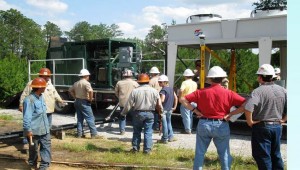Boiling Hot: How Fracking’s Gusher of Geothermal Energy is Wasted

Courtesy Gulf Coast Green Energy
Crew installing geothermal power generator at well site near Laurel, Mississippi.
There are thousands of oil & gas wells in Texas that tap into the earth’s supply of hot water, some of it a boiling hot 250 F. There are modern, high tech steam engines that could use the water to make electricity. There was a federally-funded experimental power plant that proved the technology could work in Texas.
Yet, geothermal power has gotten a cold shoulder in the state.
“They made (the power plant) work, they proved it was successful, and then they dismantled it because they didn’t have funding to keep the project going,” said Maria Richards, a researcher at Southern Methodist University’s Geothermal Laboratory.
A Texas Experiment that Worked
That 1989 project backed by the U.S. Department of Energy was called the Pleasant Bayou Power Plant. The electricity it generated would power about a 1,000 homes and was sold to what was then Houston’s utility company, HL&P.
The little power plant was located in Brazoria County in an field just ten miles north of Galveston Island which wasn’t by accident. Richards said she and colleagues have found that the hot water that comes from some two miles underground is hottest in the counties along the Gulf Coast where layers of sediment are thicker than in other parts of Texas.

Courtesty SMU
Maria Richards at Southern Methodist University researches geothermal energy
“That layer of sediment acts like an insulator so it’s similar to your blanket on a bed that it’s keeping the heat down there, ” said Richards.
The irony is that while the boom in “fracking” has meant that there are thousands of wells being drilled that could be sources of hot water, the same boom has increased the supply of natural gas. The gas is a relatively cheap fuel for big power plants and its abundance diminishes the interest in alternative sources of energy like geothermal.
A Geyser that Ran Out of Steam
It wasn’t always this way. The Texas General Land Office said at one point, geothermal energy developers had taken out nine leases for wells on state land.
“Texas has a lot of holes drilled in it already from hydrocarbon production. And that also means anyone who’d like to do geothermal energy production can go down those holes and that saves them a considerable amount of money,” said Jim Suydam, spokesperson for the Land Office.
But none of the proposed projects ever took off and the leases lapsed.
“In 2005 there was a great deal of interest in Texas geothermal. Since then there’s been a glut of natural gas on the market due to the advances of hydraulic fracturing. And that’s lowered the price of natural gas substantially and has made geothermal energy production less economically viable,” said Suydam.
But it’s backers aren’t deterred.
“The market I think is huge for this because the fact is, there are over 800,000 oil & gas wells in the United States. And there’s three million gallons per minute of hot water just in the top eight states,” said Loy Sneary, CEO of Gulf Coast Green Energy.
Sneary’s company has developed semi-truck-sized geothermal power plants that he said could provide electricity at drill and production sites. For example, in the Eagle Ford Shale region of South Texas where drilling is surging and where hot water is plentiful.
“The utilities are strapped and they’re stressed to be able to get enough power out to the oil & gas fields. With this equipment, power can be generated on-site,” said Sneary.
But other than some demonstration projects (photo above), the technology isn’t being used and the hot water that comes up from drilling is going to waste.
“It’s going back into the earth but there’s no beneficial use for that hot water. It’s an expense to the company. In fact, produced water is a very high expense for oil and gas companies,” said Sneary.